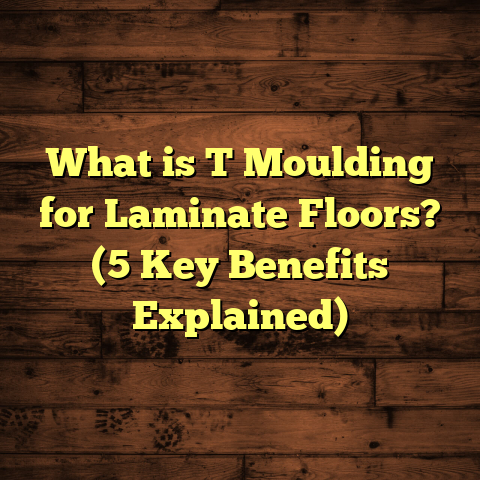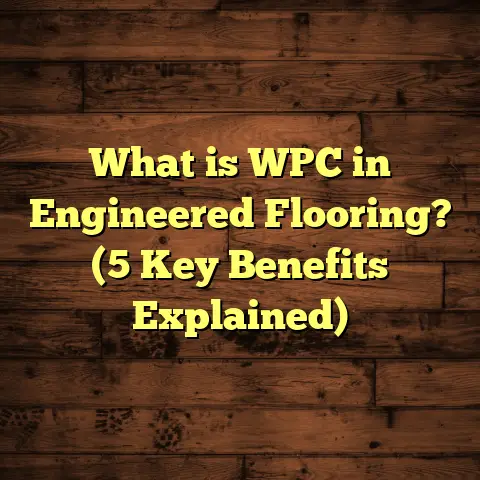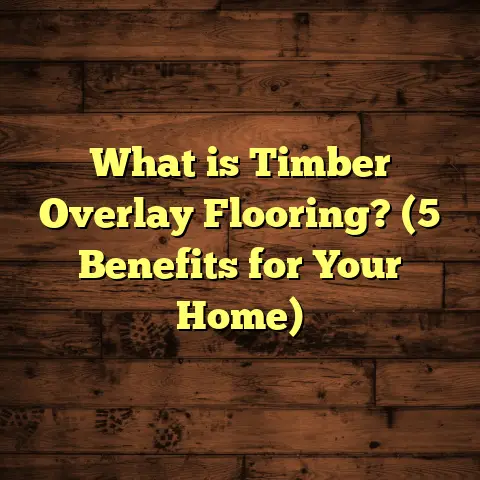What is Scraped Hardwood Flooring? (5 Benefits You Must Know)
Have you ever stopped to think about how your flooring reflects your lifestyle? Whether you’re a busy parent juggling kids and pets, a homeowner who loves hosting friends and family, or someone who just wants a beautiful, durable surface underfoot, the kind of floor you pick makes a huge impact. It affects everything—from how your home looks and feels to how it stands up to everyday wear and tear. Over my years working as a flooring contractor, I’ve seen many trends come and go. But one style that always catches my attention for its blend of rugged charm and practicality is scraped hardwood flooring. If you’re curious about what scraped hardwood is all about and why it might be perfect for your home, I’m going to share everything I’ve learned—straight from the job sites and my own experiences.
What is Scraped Hardwood Flooring?
Scraped hardwood flooring is a type of solid hardwood floor that has been intentionally distressed by scraping away softer parts of the wood grain. This creates a textured surface that feels both natural and tactile. Unlike smooth, polished hardwood floors that emphasize a sleek, glossy finish, scraped hardwood intentionally shows character, imperfections, and a certain rustic beauty.
The Concept Behind Scraped Hardwood
When you look at a typical hardwood floor, it has a smooth surface that highlights the wood’s grain pattern and color. Scraped hardwood takes a different approach—it highlights the texture. The scraping process removes the softer early wood fibers from the surface while leaving behind the denser late wood grain. This produces grooves, ridges, and an uneven surface that catches light differently and gives the floor a weathered, lived-in appearance.
This texture doesn’t just add visual interest; it changes how the floor feels underfoot. You can actually feel the grain with your toes as you walk across the room. In many ways, scraped hardwood invites people to connect with the natural material in a more intimate way than smooth floors do.
How Scraped Hardwood Flooring is Made
Understanding the manufacturing process helps appreciate the unique qualities of scraped hardwood.
- Selection of Wood Species: The process starts with choosing the right wood species. Hardwoods like white oak, red oak, hickory, maple, ash, and even walnut are popular because their grain structure allows for pronounced texturing. Hickory, for instance, is very hard (Janka hardness 1820) and offers dramatic grain patterns that show beautifully when scraped.
- Kiln Drying: Before any processing, the wood planks are kiln dried to reduce moisture content to around 6-8%. This step stabilizes the wood to prevent shrinking or warping after installation.
- Scraping Process: The heart of the operation is the scraping itself. This can be done manually using wire brushes or scrapers or by machines designed specifically for this purpose. The goal is to remove softer early wood fibers while preserving the hard late wood. This differential removal creates the texture — grooves where softer fibers were removed and raised ridges where harder fibers remain.
- Sanding: After scraping, the floorboards are lightly sanded to smooth any sharp edges without losing the texture’s character.
- Finishing: Finally, finishes like oil-based polyurethane, water-based polyurethane (for lower VOCs), or natural oils are applied. The finish protects the wood from moisture and wear but also enhances the texture by highlighting shadows and grain contrast. Some manufacturers use UV-cured finishes for added durability.
The entire process requires skill and precision because over-scraping can weaken the wood surface while under-scraping won’t provide enough texture.
My Take on Scraped Hardwood Production
I’ve visited factories where scraped hardwood floors are made, and I’m always impressed by how much craftsmanship goes into what looks like “rough” flooring. It’s not just random distressing—it’s a carefully controlled method designed to bring out the best in each species’ grain while ensuring long-term performance.
One time, I toured a plant specializing in reclaimed barn wood flooring that was scraped to highlight decades of natural wear—combining history with modern finishing techniques. That experience gave me great insight into how authenticity can be preserved even in new flooring products.
Five Benefits of Scraped Hardwood Flooring You Should Know
Let me walk you through five reasons why I often recommend scraped hardwood flooring to my clients. These benefits aren’t just theoretical—they come from real-world experience combined with industry data.
1. Durability That Matches Active Lifestyles
If you live in a household where kids play hard, pets roam freely, or you simply don’t want to worry about every little scratch, scraped hardwood is a smart choice. The textured surface naturally camouflages minor dents and scratches because they blend into the grooves rather than standing out on a smooth surface.
The National Wood Flooring Association reports that textured hardwood floors show up to 60% less visible wear compared to smooth floors under heavy traffic conditions. This makes scraped flooring particularly suitable for:
- Family rooms
- Kitchens
- Entryways
- Pet-friendly homes
I had one client with three energetic dogs who wanted a floor that could take a beating without constant refinishing. We installed white oak scraped hardwood with an oil finish. Six years later, their floors still looked fantastic despite all the foot traffic and pet nails.
2. Unique Look That Adds Character and Warmth
What draws many people to scraped hardwood is its one-of-a-kind look. Because scraping emphasizes variations in wood grain and texture, each plank has personality. It transforms a room from “standard” into cozy and inviting.
I worked on a project for a couple restoring a mid-century home who wanted something authentic yet modern. We picked maple scraped flooring with a natural finish that brought out subtle textures without overwhelming the space. When guests walked in, they’d often comment on how “lived-in” and welcoming the floors felt—without looking old or dilapidated.
The rustic style fits perfectly with farmhouse decor but also pairs well with contemporary interiors if balanced right.
3. Improved Safety Through Better Traction
Smooth hardwood floors can be slippery—especially when wet or in homes with elderly residents or young children. Scraped hardwood’s rougher texture provides better grip underfoot.
According to safety studies on flooring materials, textured finishes reduce slip hazards by nearly 30% compared to polished surfaces. That’s significant in preventing falls around:
- Staircases
- Bathrooms adjacent to kitchens
- Entryways where shoes bring moisture inside
I installed scraped hardwood for an elderly client who was concerned about falls after a minor accident on their old polished floors. Since switching to scraped flooring with an anti-slip finish, family members reported feeling safer moving around freely.
4. Easier Maintenance and Longevity
You might assume that floors with grooves and texture are harder to clean—but surprisingly, scraped hardwood is quite forgiving. Dust, dirt, and minor marks don’t show up as clearly as they do on flat floors.
Daily sweeping or vacuuming with a soft brush attachment usually keeps it looking good. For deeper cleaning, damp mop with products made specifically for hardwood floors works well without damaging finishes.
Also, because scratches blend into the texture rather than stand out sharply, resurfacing or refinishing jobs become less frequent. This saves time and money over the life of your floor.
5. Environmentally Friendly Option
Many scraped hardwood floors are made from sustainably harvested or reclaimed wood sources. Using reclaimed wood not only reduces demand for new timber but also brings historical character into your home.
One renovation I worked on used barn wood salvaged from a 19th-century farmstead near my town. After careful cleaning and scraping, we installed it as flooring in a modern kitchen—blending old-world charm with new-world durability.
Plus, because scraping removes less material than sanding during refinishing cycles, there’s less waste produced over time.
Personal Stories: Real-Life Applications of Scraped Hardwood Flooring
To give you more perspective on how scraped hardwood performs in different environments, here are some stories from projects I’ve done over the years:
The Dog-Friendly City Loft
A young couple living in an urban loft wanted durable floors for their two large dogs but didn’t want laminate or vinyl because those felt cheap to them. We installed engineered oak scraped hardwood with matte finish throughout their living spaces.
They loved how scratches blended into the texture instead of ruining the look after just a few weeks—a common problem they’d had before with smooth floors. The loft’s industrial aesthetic matched perfectly with the rustic feel of scraped wood.
Historic Home Restoration
In an old farmhouse renovation project, scraped hickory floors helped preserve authenticity while upgrading durability for modern living conditions. The original wide-plank floors were too damaged to keep.
Using new hickory boards scraped to mimic aged wood allowed us to maintain the home’s character without compromising quality or warranty terms required by their insurance company.
Vacation Cabin Retreat
For a mountain cabin getaway, clients wanted floors that felt “natural” and could withstand dirt tracked in from hiking boots and snowshoes.
Scraped ash flooring did just that—the texture made dirt less obvious between cleanings, and its hardness meant fewer scratches from heavy boots or furniture moves during seasonal use.
Technical Details That Make Scraped Hardwood Stand Out
Understanding some core technical specs can help you decide if scraped hardwood fits your needs:
| Feature | Details |
|---|---|
| Wood Species | Oak (red/white), hickory, maple, ash |
| Janka Hardness | Hickory (1820), Maple (1450), Oak (1290) |
| Plank Thickness | Typically 3/4 inch solid; engineered varies |
| Width Range | Narrow (3″) to wide planks (up to 7″) |
| Moisture Content | Kiln-dried to 6-8% |
| Finish Types | Oil-based polyurethane; water-based polyurethane; natural oils |
| Installation | Nail/staple down; glue down (engineered); floating options limited |
| Warranty | Often 25+ years on finish wear |
Why Janka Hardness Matters
The Janka hardness rating measures how resistant wood species are to denting or wear by quantifying how much force it takes to embed a steel ball halfway into the wood.
For scraped flooring designed to last in high traffic areas—especially homes with pets or kids—choosing species with higher Janka values like hickory (1820) or hard maple (1450) pays off over time by reducing visible damage.
Installation Considerations
Scraped hardwood installation requires some special attention:
- Acclimation: Wood must acclimate in your home environment for at least 48-72 hours before installation to minimize expansion/shrinkage.
- Subfloor Prep: Subfloor must be level and clean; uneven surfaces can cause squeaks or gaps.
- Handling Texture: Installers must handle planks carefully to avoid damaging raised grains.
- Finish Touch-Ups: Sometimes an extra coat of finish post-installation protects exposed grain edges better.
Experienced installers familiar with textured hardwood will produce better results than general contractors who haven’t worked with this style much.
Cost Breakdown: How Much Does Scraped Hardwood Flooring Really Cost?
Pricing is often top of mind for homeowners considering new flooring. Scraped hardwood generally costs more than standard smooth hardwood due to extra labor during scraping and finishing—but it offers long-term value through durability and reduced maintenance needs.
Here’s an approximate cost guide per square foot installed:
| Flooring Type | Price Range (Installed) |
|---|---|
| Smooth Hardwood | $6 – $12 |
| Scraped Hardwood | $7 – $13 |
| Engineered Hardwood | $5 – $11 |
| Laminate | $3 – $7 |
| Vinyl Plank | $2 – $6 |
Prices vary depending on wood species (exotic woods cost more), plank width (wider planks cost more), finish type (natural oils typically pricier), and labor rates in your area.
Making Budget Decisions
When budgeting for scraped hardwood flooring:
- Factor in subfloor prep costs if needed.
- Include extra costs for moving furniture or custom finishes.
- Consider potential savings on refinishing over time due to better scratch concealment.
- Remember resale value: quality hardwood improves home value more than synthetic alternatives.
How Scraped Hardwood Fits Different Design Styles
Scraped hardwood’s versatility surprises many people. Although it often conjures rustic or farmhouse images, it can work beautifully in diverse interior styles:
Rustic & Farmhouse
This is where scraped hardwood shines brightest—its worn-in texture pairs naturally with reclaimed wood furniture, shiplap walls, and cozy textiles.
Industrial & Urban Loft
The raw feel complements concrete walls, metal accents, and open floor plans typical of loft apartments or converted warehouses.
Modern & Minimalist
Subtle textures add warmth without overpowering clean lines if you choose lighter stains and narrower planks.
Transitional & Traditional
Scraped oak finished in warm tones can blend seamlessly into classic interiors looking for authentic materials but modern durability.
Addressing Common Questions About Scraped Hardwood Flooring
I get asked these questions frequently—here are my straightforward answers:
Q: Will scraped floors be harder to keep clean?
A: Not really! The texture hides dust better than smooth floors. Regular sweeping and occasional damp mopping keep them looking great without extra effort.
Q: Can scraped hardwood be refinished?
A: Yes! But refinishing requires care so you don’t remove too much texture during sanding. Professional refinishers use specialized techniques for textured floors.
Q: Do pets cause more damage on scraped floors?
A: Actually less visible damage because scratches blend into grooves. Just keep nails trimmed for best results.
Q: Is scraped hardwood noisy underfoot?
A: No more than regular hardwood if installed properly over soundproofing underlayments.
Q: Can I install it myself?
A: Installation is tricky due to texture; I recommend hiring experienced pros unless you have advanced DIY skills.
Wrapping Up My Thoughts on Scraped Hardwood Flooring
After years of installing all kinds of flooring, scraped hardwood continues to impress me as a smart choice for many homeowners who want something both practical and beautiful. It combines rugged durability with timeless style in a way few other materials do.
If you want floors that will show character gracefully over time—not just hide wear but celebrate it—then scraped hardwood might be exactly what your home needs.
Are you ready to explore this option further? I’m happy to help you figure out what species and finishes would work best based on your lifestyle and tastes. Feel free to ask anytime!





